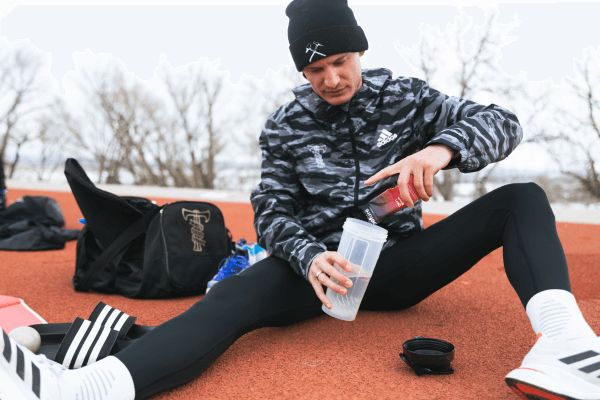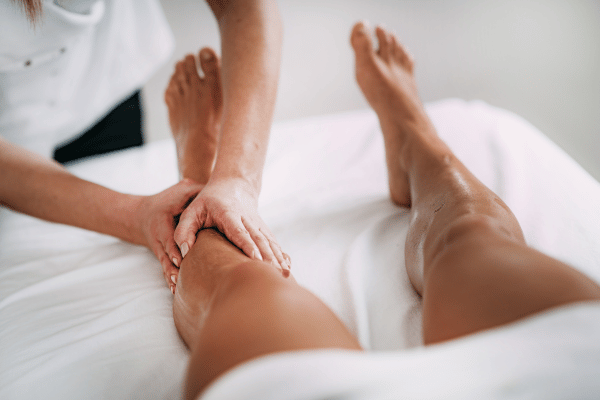I'm too tired.
I don't have time.
I'm still sore from my last workout.
It's wet outside.
I'll do it tomorrow.
Do you ever feel like your running shoes come with a built-in excuse generator?
We hear you!
Sometimes, getting out the door can be a battle against that inner voice whispering "maybe tomorrow."
That's why more than one person has said, "The hardest part of running is putting your shoes on."
There's no easy answer, but start by developing some simple running habits that can make it easier to get you out the door and loving the miles.
Five Habits to Make You A Better Runner
Whether you're just starting out with a jog around the park or you're a seasoned athlete, you're chasing two things:
- make consistent progress
- have fun doing it
Follow these five science-backed strategies to create a pre-workout routine for a runner that will deliver exactly that:
1. Setting the Right Mindset
To put together an effective pre-workout routine, it's important to start by setting the right mindset.
Let's face it, running isn't easy. Sometimes it can feel more like a punishment than pleasure, especially in the beginning.
Positive Self-Talk
So what if we flipped the script?
Instead of "Ugh, I have to go for a run," reframe it as "Awesome! I can lace up my shoes and clear my head."
When you do something like this, you're using a technique called positive self-talk to change how you think about running. It can be as easy as using "I can" instead of "I should" or "I have to" when you catch yourself making excuses.
Here are some other examples of using positive self-talk :
Instead of: "I should run faster."
Try: "I can gradually increase my pace as I feel stronger."
Instead of: "I should run further today."
Try: "I can choose a slightly longer route today and see how I feel."
See our blog for more on self-talk for runners.
Visualization
Visualization is similar to self-talk because it's a way of using your mind to get your body to do things. Basically, you imagine something happening now or in the future and make it as positive (and fun) as possible.
Examples of how you might do this are:
Imagine running through that beautiful park, enjoying the fresh air and scenery." (Focus on the enjoyable aspects of your run as an incentive to get you out there.)
Seeing yourself conquering that hill up ahead. My legs getting stronger with each stride." (Visualize yourself successfully completing a challenging part of your run.)
By using positive self-talk and visualization you control how you feel about running - and get you out the door with a smile.
2. Choose Your Music:
There are two schools of thought when it comes to exercise and music.
For some people, the whole point of exercising is to give the mind some peace and quiet to recover and think. If that's the case, leave the headphones at home and just enjoy the rhythm of your feet hitting the ground.
For those who need an extra push, there's nothing like a musical beat to help you out.
Research shows music with a tempo of 120-140 beats per minute (BPM) can boost your mood and make you forget you're feeling tired. Just as important, it should put a smile on your face.
Take a look at some suggestions below which cover warm up to top-speed. If you want to check out how your favorite songs stack up at https://songbpm.com/
- "Eye Of The Tiger" - Survivor (BPM: 108)
- "Walking On Sunshine" - Katrina and the Waves (BPM 110)
- "Raise Your Glass" - P!nk (BPM 122)
- "Run the World (Girls)" - Beyoncé (BPM: 128)
- "Applause" – Lady Gaga (BPM 140)
- "Brightside" – The Killers (148 BPM)
- "Happy" - Pharrell Williams (BPM: 163)
It's also a chance to listen to podcasts and brushup your running knowledge. Here are three to get you started.
3. Partner Up or Join a Group:
Grab a friend for your pre-run routine, or consider joining a running group. Other people can make running more fun, motivate you to push harder, and even provide some friendly competition if you need it.
If you can't find a group in your area there are some great social groups online. If you like to run alone (or just don't want to stick to specific times), try a running app like Strava. They're a great way to get (and give) encouragement.
Join 2before's Strava group on this link.
4. Pre-Run Stretch with Dynamic Movements:
Before starting your run, warm up with dynamic exercises. These help increase your heart rate, improve blood flow to your muscles, and enhance your range of motion.
Think about exercises like leg swings, high knees, butt kicks, and lunges to activate your muscles. Remember to start gradually and increase the intensity as you go.
Dynamic stretches can feel more active and engaging compared to static stretches, but both are important when it comes to preventing injury.
These stretches and movements should also be a part of your cool-down routine when you've finished your workout. Check out our nutrition and recovery blog for athletes for more detail.

5. Using Pre-Workout Supplements
Running burns calories - it's a key reason a lot of us do it!
Make sure to eat a balanced meal containing carbohydrates, protein, and healthy fats about 2-3 hours before your workout. This, along with drinking plenty of water to keep you hydrated, will give you the energy to perform at your best.
In addition to a healthy diet, some runners may benefit from adding supplements into their pre-workout routine.
There are a lot of pre-workout supplements out there.
2before's blackcurrant pre-workout is made with New Zealand blackcurrant berries, which have been shown to help with energy, endurance and recovery. It's 100% natural, mixes well with any other supplements you're taking and tastes great. Think of it as a treat to help you get out the door!
Your Running Habit For A Lifetime
Mindset, music, people, stretching and supplements.
These are five things you can use to start a pre-workout routine that can help you become a better runner.
Ultimately everyone has their own reasons for running, the important thing is to get into a habit that suits you and your goals. Hopefully these ideas will give you some ideas on how to make it easier to lace up and get out the door.
References:
Hatzigeorgiadis, Antonis & Nikos, Comoutos Former Zourbanos & Mpoumpaki, Sofia & Theodorakis, Yannis. (2009). Mechanisms underlying the self-talk–performance relationship: The effects of motivational self-talk on self-confidence and anxiety. Psychology of Sport and Exercise. 10. 186-192. 10.1016/j.psychsport.2008.07.009.



